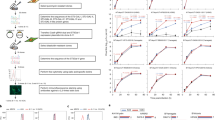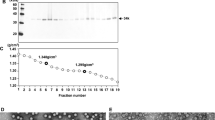Abstract
RAPP et al.1 described a method for producing SV 40 ‘T’ antigen free of virion by using cytosine arabinoside (CA) to block the growth of virus in tissue cultures of cercopithecus kidney cells. We found that cytosine arabinoside could also be used to produce virus-free adenovirus 12 ‘T’ antigen in human cell tissue cultures as follows: It was found that the pH of the media and the condition of the human cell lines (HEK, HeLa or KB monolayers) used to produce adenovirus 12 ‘I’ antigens could be best controlled in test-tubes and that when this was done more uniform production of “I” antigen was obtained. About three hundred test-tubes were used for each experiment. Evenly growing cell monolayers wore drained of fluid and washed with Eagle's basal medium containing 4 mM glutamine plus antibiotics. Each culture was then inoculated with 0.2 c.c. virus mixture (virus diluted with Eagle's basal medium containing 4 mM glutamine plus antibiotics) at multiplicities between 1 and 2 TCID50 per cell. The cultures were incubated for 1 h at 34° C and then each was fed 1 c.c. of a mixture of Eagle's basal medium + 2 per cent A-γ calf serum + 2mMglutamine + antibiotics + 10γcytosine arabinoside. 72 h after infection, the media were drained and the cultures were washed with large quantities of Eagle's basal medium and overlaid with 0.2 c.c. Eagle's basal medium + antibiotics + 4 mM glutamine. The cells were frozen in the test-tubes on a slant, thawed quickly, pooled, homogenized and clarified at 2,000 r.p.m. for 10 min. The resulting material was concentrated forty to fifty times by Kohn's method2, and three hundred test-tubes yielded 6 c.c. of crude ‘I’ antigen. A large number of replicate experiments using this method yielded results comparable with those presented in Table 1. Adenovirus ‘I’ antigen produced in HEK monolayers in the presence of cytosine arabinoside had an average complement-fixed antigen titre of 1 : 32, whereas, when produced in HeLa and KB cells, the average titre achieved was 1:8. In other experiments using cytosine arabinoside, a multiplicity of 10 TCID50 adenovirus 12 per cell yielded about the same ‘T’ antigen titre, but virion antigen was not inhibited and 30-day infectivity titrations in HEK cells showed the presence of at least one log of virus.
This is a preview of subscription content, access via your institution
Access options
Subscribe to this journal
Receive 51 print issues and online access
$199.00 per year
only $3.90 per issue
Buy this article
- Purchase on Springer Link
- Instant access to full article PDF
Prices may be subject to local taxes which are calculated during checkout
Similar content being viewed by others
References
Rapp, F., Melnick, J. L., and Kitahara, T., Science, 147, 625 (1965).
Kohn, V., Nature, 183, 1055 (1959).
Melnick, J. L., and Rapp, F., Ann. N.Y. Acad. Sci., 130, 291 (1965).
Rowe, W. P., Baum, S. G., Pugh, W. E., and Hoggan, M. D., J. Exp. Med., 122, 943 (1965).
Gilead, Z., and Ginsberg, H. S., J. Bact., 90, 120 (1965).
Huebner, R. J., Rowe, W. P., Turner, H. C., and Lane, W. T., Proc. U.S. Nat. Acad. Sci., 50, 379 (1963).
Hoggan, M. D., Rowe, W. P., Black, P. H., and Huebner, R. J., Proc. U.S. Nat. Acad. Sci., 53, 12 (1965).
Author information
Authors and Affiliations
Rights and permissions
About this article
Cite this article
HOLLINSHEAD, A., HUEBNER, R. Adenovirus 12 Virion-free ‘T’ Antigen from Infected Cells inhibited with Cytosine Arabinoside. Nature 210, 1381–1383 (1966). https://doi.org/10.1038/2101381b0
Published:
Issue Date:
DOI: https://doi.org/10.1038/2101381b0
This article is cited by
-
Comparative study by immunofluorescence of T and P antigens induced by adenovirus type 12 in permissive and nonpermissive cells
Archives of Virology (1978)
-
Separation of two components of adenovirus type 12 induced T-antigens with sephadex G-50
Experientia (1968)
-
Heat-labile Macroglobulin revealed in Adenovirus 12 Tumour Sera by Gel Electrophoresis
Nature (1967)
-
Adenovirus Antibody and Antibody to ‘T’ Antigen (Neoantigen) Location in Gamma-globulin
Nature (1966)
Comments
By submitting a comment you agree to abide by our Terms and Community Guidelines. If you find something abusive or that does not comply with our terms or guidelines please flag it as inappropriate.



